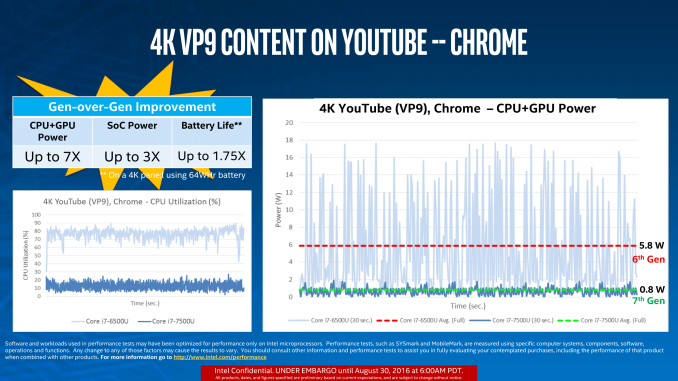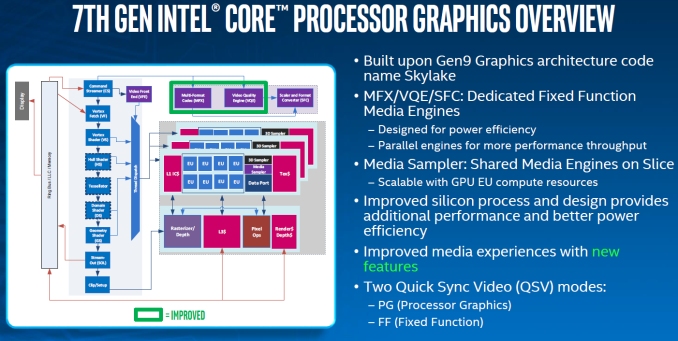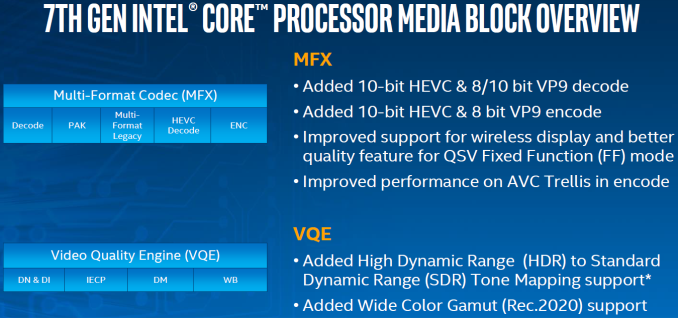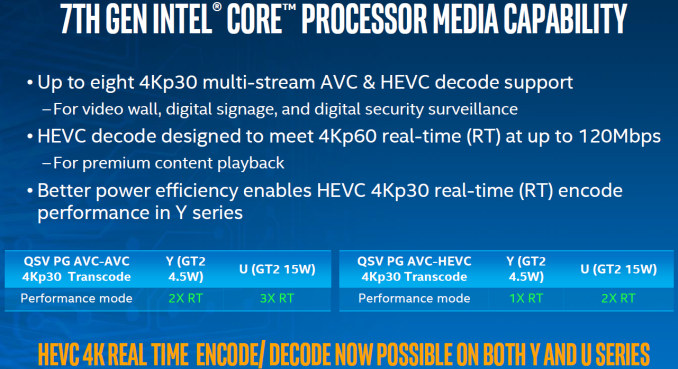Intel Announces 7th Gen Kaby Lake: 14nm PLUS, Six Notebook SKUs, Desktop coming in January
by Ganesh T S & Ian Cutress on August 30, 2016 9:00 AM EST- Posted in
- CPUs
- Intel
- 14nm
- Kaby Lake
- Gen 9
- Speed Shift
- Turbo Boost
The Kaby Lake-U/Y GPU - Media Capabilities
While from a feature standpoint Kaby Lake is not a massive shift from Skylake, when it comes to GPU matters it none the less brings across some improvements that are directly visible to the end-user. As with the CPU cores, Intel’s 14nm+ process will allow for higher GPU frequencies and overall better GPU performance, but arguably the more impressive change with Kaby Lake is the updated media capabilities. To be clear, Kaby Lake is still an Intel Gen9 GPU – the core GPU architecture has not changed – but Intel has revised the video processing blocks to add further functionality and improve their performance for Kaby Lake.
The media capabilities of the Skylake GPU was analyzed in great detail in our 2015 IDF coverage. The updates to Kaby Lake-U/Y should be analyzed while keeping those features in mind. The major feature change in the Kaby Lake-U/Y media engine is the availability of full hardware acceleration for encode and decode of 4K HEVC Main10 profile videos. This is in contrast to Skylake, which can support HEVC Main10 decode up to 4Kp30, but does so using a “hybrid” process that spreads out the workload over the CPU, the GPU’s media processors, and the GPU’s shader cores. As a result, not only can Kaby Lake process more HEVC profiles in fixed function hardware than before, but it can do so at a fraction of the power and with much better throughput.
Also along these lines, Kaby Lake has implemented full fixed function 8-bit encode and 8/10-bit decode support for Google’s VP9 codec. Skylake offered hybrid decode support for the codec, which is useful from a feature standpoint, but is a bit more problematic in real-world use since it’s not as power-efficient to use VP9 a codec implemented in fixed function hardware. Google has proven eager to serve up VP9 to its YouTube users, so they can now much more efficiently decode the codec. Meanwhile, on the encode side, brand-new to Kaby Lake is VP9 encoding support, to go with the aforementioned HEVC encode support.
| Intel Video Codec Support | |||||
| Kaby Lake | Skylake | Broadwell | |||
| H.264 Decode | Hardware | Hardware | Hardware | ||
| HEVC Main Decode | Hardware | Hardware | Hybrid | ||
| HEVC Main10 Decode | Hardware | Hybrid | No | ||
| VP9 8-Bit Decode | Hardware | Hybrid | Hybrid | ||
| VP9 10-Bit Decode | Hardware | No | No | ||
| H.264 Encode | FF & PG-Mode | FF & PG-Mode | PG-Mode | ||
| HEVC Main Encode | FF & PG-Mode | PG-Mode | No | ||
| HEVC Main10 Encode | FF & PG-Mode | No | No | ||
| VP9 8-Bit Encode | FF & PG-Mode | No | No | ||
| VP9 10-Bit Encode | No | No | No | ||
An overview of the GPU engine in Kaby Lake-U/Y is presented in the slide below.
The new circuitry for hardware accelerating HEVC Main10 and VP9 are part of the MFX block. The MFX block can now handle 8b/10b HEVC and VP9 decode and 10b HEVC / 8b VP9 encode. The QuickSync block also gets a few updates to improve quality further, and AVC encode performance also receives a boost.
The Video Quality Engine also receives some tweaks for HDR and Wide Color Gamut (Rec.2020) support. Skylake's VQE brought in RAW image processing support with a 16-bit image pipeline for selected filters. While Intel has not discussed the exact updates that enable Rec.2020 support, we suspect that more components in the VQE can now handle higher bit-widths. Intel pointed out that the HDR capabilities involve usage of both the VQE and the EUs in the GPU. So, there is still scope for further hardware acceleration and lower power consumption in this particular use-case.
Intel claims that Kaby Lake-U/Y can handle up to eight 4Kp30 AVC and HEVC decodes simultaneously. HEVC decode support is rated at 4Kp60 up to 120 Mbps (especially helpful for premium content playback and Ultra HD Blu-ray). With Kaby Lake-U/Y's process improvements, even the 4.5W TDP Y-series processors can handle real-time HEVC 4Kp30 encode.
On the subject of premium content, in their presentation Intel rather explicitly mentioned that the improved decode capabilities were, in part, for “premium content playback.” When we pushed Intel a bit on the matter – and specifically on 4K Netflix support – they didn’t have much to say beyond the fact that to play 4K Netflix, you need certification. Based on what was said and what was not said (and what we know about the certification process) our educated guess is that the updates in Kaby Lake-U/Y include some new DRM requirements for 4K content, and 4K Netflix should hopefully be good to go with the new platform. However on that note, because of those DRM requirements and that this is being pitched as a new feature for Kaby Lake, we suspect that when 4K Netflix streaming does come to the PC platform, Skylake owners are going to be out of luck.
Update: On a related note, one of the Intel press releases that has gone out today is that Sony's 4K movie and television streaming service, ULTRA, will be coming to Kaby Lake PCs in 2017. To date the service has only been available on Sony's televisions - in part for security reasons - so this is an example of one such premium content service that's coming to Kaby Lake thanks to its stronger DRM abilities.
It must be kept in mind that all the encode / decode aspects discussed above are for 4:2:0 streams. This is definitely acceptable for consumer applications, as even Blu-ray video streams (that have plenty of bandwidth at their disposal) are encoded in 4:2:0. However, if Intel wants to use the new media engine in professional broadcast and datacenter applications, 4:2:2, and, to a much lesser extent, even 4:4:4 support might become necessary. For the purpose of the Kaby Lake-U/Y consumer platforms being introduced today, this is not an issue at all.
Moving on, like the GPU core itself, Kaby Lake-U/Y's display pipeline is the same as that of Skylake. This means the iGPU can support up to three simultaneous displays.

One of the disappointing aspects from Skylake that has still not been addressed in Kaby Lake-U/Y is the absence of a native HDMI 2.0 port with HDCP 2.2 support. Intel has been advocating the addition of an LSPCon (Level Shifter - Protocol Converter) in the DP 1.2 path. This approach has been used in multiple motherboards and even SFF PCs like the Intel Skull Canyon NUC (NUC6i7KYK) and the ASRock Beebox-S series. Hopefully, future iterations of Kaby Lake (such as the desktop and high-performance mobile parts coming in January) address this issue to simplify BOM cost for system vendors.
In summary, Kaby Lake-U/Y resolves one of the major complaints we had about Skylake's media engine: the absence of hardware-accelerated 4Kp60 HEVC Main10 decode. There are a few other improvements under the hood that enable a more satisfying multimedia experience for consumers. The software and content-delivery ecosystems have plenty of catching up to do when it comes to taking full advantage of Kaby Lake-U/Y's media capabilities.














129 Comments
View All Comments
CaedenV - Tuesday, August 30, 2016 - link
yep, virtu never worked on my SB z68 motherboard, but I upgraded to a z77 board (same SB CPU) to support TRIM over RAID0/1 for my SSDs and was happy to find that Virtu worked as advertised on the newer board. Used it to rip DVDs and BluRays for a few years, but more recently moved to a newer dGPU as I re-ripped my collection to h.256 to save on server space.inighthawki - Tuesday, August 30, 2016 - link
It is typically a BIOS option to enable/disable the iGPU in the presence of a discrete GPU. Enabling it should have no ramifications, though, and the iGPU should simply show up as another video adapter on the system (no different than if you plug in an AMD and NVIDIA card at the same time). I've done this before on my machines and I've never had windows fail to boot - what configuration do[/did] you have? Perhaps the discrete GPU driver attempted to configure the system as a hybrid configuration (e.g. like on laptops) but it was not compatible for some reason?Guspaz - Tuesday, August 30, 2016 - link
It was the bios setting that I attempted to enable. It's an i7-3770 on a Z77 motherboard and an nVidia GPU (670 at the time) on what was originally Windows 7. Windows 8 didn't help, and I've not tried it with my current GPU (970) or OS (Win10).inighthawki - Tuesday, August 30, 2016 - link
hmm odd. I haven't ever tried on Windows 7 (or ivy bridge, for that matter), but my haswell works flawlessly alongside my GTX 780Ti in windows 10. I would suspect it could just be a driver issue.CaedenV - Tuesday, August 30, 2016 - link
Ivy still required lucid to work (my wife's desktop does not have it, so I can pick one or the other). But newer boards came with the feature as standard.Still, enabling the onboard graphics should not bring instability. Must be a bad iGPU or a driver issue at play there. enabling the iGPU should just turn off the dGPU in systems without virtu.
techieboi - Thursday, September 1, 2016 - link
I doubt it is possible as yet. But there was a similar hack I read on http://gadgetspost.com, you could try. Not sure though.Shadowmaster625 - Tuesday, August 30, 2016 - link
PAO? More like TTM. Tick. Tock. Milk.Drumsticks - Tuesday, August 30, 2016 - link
To be fair, a 12% performance boost on mobile is pretty fair, considering it's higher than some new generations have managed with new uArchs or entirely new process nodes.tipoo - Tuesday, August 30, 2016 - link
Tick Tock ToeTEAMSWITCHER - Tuesday, August 30, 2016 - link
Can someone please explain to me Intel's product introduction strategy? Why would they want to sell the lower-cost non-Iris Pro Kaby Lake chips first? This makes no sense...essentially diluting the demand for the "better" chips by putting the "lesser" chips on the markets MONTHS before hand.I understand that PC makers love these "bread and butter" = "ho-hum" SKU's, and can't wait to sell "Kaby Lake" versions of products they are selling right now, but WOW! One would think that Intel would at least attempt to improve profitability by making the "better" (Iris PRO) chips available at the same time. I just don't see the logic...